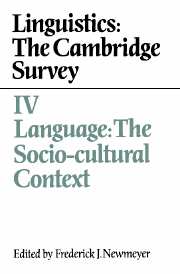Book contents
- Frontmatter
- Contents
- Contributors
- Preface
- 1 The study of language in its socio-cultural context
- 2 Language, culture, and world-view
- 3 Language and social class
- 4 Language and race: some implications for linguistic science
- 5 Language and gender
- 6 Bilingualism
- 7 Dialectology
- 8 Sociolinguistics and syntactic variation
- 9 Language birth: the processes of pidginization and creolization
- 10 Language death
- 11 Language planning: the view from linguistics
- 12 Ethnography of speaking: toward a linguistics of the praxis
- 13 The organization of discourse
- 14 Conversation analysis
- Index of names
- Index of subjects
- Contents of Volumes I, II, and III
3 - Language and social class
Published online by Cambridge University Press: 05 June 2012
- Frontmatter
- Contents
- Contributors
- Preface
- 1 The study of language in its socio-cultural context
- 2 Language, culture, and world-view
- 3 Language and social class
- 4 Language and race: some implications for linguistic science
- 5 Language and gender
- 6 Bilingualism
- 7 Dialectology
- 8 Sociolinguistics and syntactic variation
- 9 Language birth: the processes of pidginization and creolization
- 10 Language death
- 11 Language planning: the view from linguistics
- 12 Ethnography of speaking: toward a linguistics of the praxis
- 13 The organization of discourse
- 14 Conversation analysis
- Index of names
- Index of subjects
- Contents of Volumes I, II, and III
Summary
Introduction
In all human societies individuals will differ from one another in the way they speak. Some of these differences are idiosyncratic, but others are systematically associated with particular groups of people. The most obvious of these are associated with sex and developmental level: women speak differently from men, and children differently from adults. These two dimensions of social variation in language are in part biologically determined (e.g. differences in laryngeal size producing different pitch levels for adult men and women), but in most societies they go beyond this to become conventional and socially symbolic. Thus men and women differ by far more in language use than mere pitch. (In fact, even their pitch differences are more pronounced than can be anatomically explained.) Such sociosymbolic aspects of language use serve an emblematic function: they identify the speaker as belonging to a particular group, or having a particular social identity.
In many societies some of the most important of these sociolinguistic divisions are associated with differences in social prestige, wealth, and power. Bankers clearly do not talk the same as busboys, and professors don't sound like plumbers. They signal the social differences between them by features of their phonology, grammar, and lexical choice, just as they do extralinguistically by their choices in clothing, cars, and so on.
- Type
- Chapter
- Information
- Linguistics: The Cambridge Survey , pp. 37 - 63Publisher: Cambridge University PressPrint publication year: 1988
- 16
- Cited by



